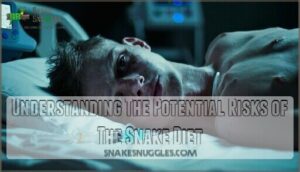This site is supported by our readers. We may earn a commission, at no cost to you, if you purchase through links.
 The snake diet two hour eating window restricts all your daily food intake to just 1-2 hours, followed by extended fasting periods of 24-72 hours.
The snake diet two hour eating window restricts all your daily food intake to just 1-2 hours, followed by extended fasting periods of 24-72 hours.
You’ll eat one large meal during this narrow window, then fast completely until your next eating period.
While proponents claim rapid weight loss, this extreme approach carries significant risks including nutrient deficiencies, metabolic slowdown, and potential eating disorder development.
Most nutrition experts consider this protocol too restrictive for safe, sustainable results, citing the intense hunger and social limitations that make long-term adherence nearly impossible for most people.
Understanding both the appealing promises and serious health concerns can help you make an informed decision about this controversial fasting method.
Table Of Contents
- Key Takeaways
- What is The Snake Diet Eating Window?
- How to Survive The Snake Diet 48-Hour Fast
- Does The Snake Diet Really Promote Weight Loss?
- Understanding The Potential Risks of The Snake Diet
- Debunking The Snake Diet’s Health Benefits Claims
- Finding Alternative Approaches to Weight Loss
- Breaking The Sugar Addiction With The Snake Diet
- Frequently Asked Questions (FAQs)
- What is the eating window for the snake diet?
- What is the Snake Juice fast for 48 hours?
- What is the 2 meal a day eating window?
- How long should your eating window be when fasting?
- Can anyone participate in the Snake Diet program safely?
- How does the Snake Diet address hunger and cravings effectively?
- Is the Snake Diet suitable for individuals with medical conditions?
- Can pregnant women safely follow snake diet?
- What happens after stopping the snake diet?
- How does snake diet affect athletic performance?
- Conclusion
Key Takeaways
- You’ll restrict your eating to just 2 hours daily followed by 22-48 hour fasting periods, which creates severe calorie restriction but often leads to nutrient deficiencies and muscle loss rather than sustainable fat burning.
- You’ll face serious health risks including gallstone formation, severe constipation, fatigue, dizziness, and potential eating disorder development due to the extreme nature of this fasting protocol.
- You won’t find scientific evidence supporting the Snake Diet’s bold claims about curing diabetes or herpes – these unsubstantiated promises lack peer-reviewed research and could delay proper medical treatment.
- You’ll likely experience weight rebound once you stop the diet since the extreme restrictions aren’t sustainable long-term, making moderate intermittent fasting approaches like 16:8 windows safer and more effective alternatives.
What is The Snake Diet Eating Window?
The Snake Diet’s eating window restricts your food intake to just two hours per day, following a 48-hour fast period.
This extreme approach means you’ll consume all your daily calories within this tiny window while fasting for the remaining 22 hours.
Overview of The Snake Diet’s Eating Window
The Snake Diet’s eating window represents extreme restriction – you’ll fast for 22 hours, then eat everything within a tight two hour window.
This fasting window creates dramatic calorie intake reduction while forcing meal composition toward ketosis induction.
The eating window timing becomes your daily anchor, though this approach carries serious social impact as you’ll miss most shared meals, which can be a significant social impact.
Benefits of a 2-Hour Eating Window
While cutting your eating window down to two hours might sound extreme, it can deliver some impressive benefits for your body and mind.
- Increased satiety – You’ll feel fuller longer when meals are condensed
- Enhanced insulin sensitivity – Your body responds better to blood sugar changes
- Significant calorie reduction – Less time eating naturally means fewer calories
- Ketosis induction – Extended fasting periods trigger fat-burning mode
- Accelerated fat burning – Your body taps into stored energy reserves
- Simplified meal planning – No more constant food decisions throughout the day
- Reduced food obsession – Less mental energy spent thinking about your next meal
- Better appetite control – Hormones adjust to support your new eating pattern
The snake diet’s two hour window creates a powerful intermittent fasting approach that can kickstart weight loss through these natural metabolic changes.
This approach aligns with research suggesting that time-restricted eating can improve health outcomes.
Drawbacks of a Short Eating Window
While the 2-hour eating window might seem appealing, it brings serious downsides that can’t be ignored.
The two-hour eating window sounds appealing but creates serious nutritional and social challenges that outweigh potential benefits.
Your body struggles to get enough nutrients in such a short time, leading to nutrient deficiencies and potential muscle loss. The diet’s restrictive nature may require sipping snake juice to maintain electrolyte balance.
| Physical Effects | Social Impact | Mental Health |
|---|---|---|
| Nutrient deficiencies | Social isolation at meals | Psychological harm |
| Muscle loss concerns | Missing family dinners | Disordered eating patterns |
| Energy crashes | Avoiding food events | Obsessive food thoughts |
| Digestive issues | Relationship strain | Anxiety around eating |
Extreme fasting periods often trigger weight rebound once you return to normal eating patterns, making long-term success unlikely.
How to Survive The Snake Diet 48-Hour Fast
Starting a 48-hour fast can feel overwhelming, but proper preparation makes it manageable.
You’ll need the right mindset, electrolyte support, and realistic expectations to get through those challenging first two days.
Preparing for The 48-Hour Fast
Before your 48hour fast begins, you’ll need proper electrolyte loading and mental preparation.
Stock up on Snake Juice ingredients to maintain electrolyte balance throughout the fast. Clear your schedule of social eating events and prepare low-carb, pre-fast foods for your last meal.
Mental preparation means accepting hunger pangs as temporary. Reduce activity levels during fasting to prevent dehydration and manage energy reserves effectively, ensuring a safe and successful fast with proper mental preparation.
Tips for Staying Hydrated and Energized
Staying hydrated during your 48-hour fast isn’t just about chugging water. You’ll need electrolyte-rich drinks to maintain proper electrolyte balance and avoid dehydration issues.
Snake Juice serves as your primary electrolyte drink, helping combat fatigue while supporting steady energy sources. Staying properly hydrated can be easier with convenient drink options.
Sip consistently rather than gulping large amounts. Light walking can help manage hunger management without draining your activity levels.
Common Challenges During The Fast
During your 48-hour fast, you’ll face several tough hurdles that can derail even the most determined dieter. Your body will fight back against this extreme restriction.
Common challenges include:
- Hunger pangs – Intense stomach cramping that peaks around hour 18-24
- Fatigue and headaches – Energy crashes from nutrient deficiencies and dehydration
- Mood swings and dizziness – Blood sugar drops affecting mental health
- Social isolation – Missing meals with family creates relationship strain
- Rebound weight concerns – Risk of overeating when the fast ends
Does The Snake Diet Really Promote Weight Loss?
You might expect dramatic weight loss results from the Snake Diet‘s two-hour eating window, but the reality is more complicated than the bold claims suggest.
While some people do lose weight quickly, the extreme restrictions raise serious questions about whether this approach is safe or sustainable for most people.
The Science Behind The Snake Diet’s Weight Loss Claims
When you break down the Snake Diet, rapid weight loss happens through calorie restriction, not magic.
Your body shifts into ketosis induction as fat oxidation kicks in. The two-hour eating window creates severe metabolic effects, improving insulin sensitivity.
However, that initial drop you’ll see comes mostly from water and muscle loss, not just fat burning.
The diet’s creator, Cole Robinson’s credentials, have been questioned due to his lack of formal nutritional training.
Criticisms of The Snake Diet’s Restrictive Nature
Critics point out that the snake diet’s extreme fasting creates serious health risks including nutrient deficiencies and mental health concerns.
This unhealthy approach can trigger disordered eating patterns and push your body into starvation mode.
Many people experience rebound weight gain when they can’t sustain such restrictive habits long-term.
Understanding The Potential Risks of The Snake Diet
While the Snake Diet’s extreme fasting approach might seem appealing for rapid weight loss, you’re putting your body through significant stress that can lead to serious health complications.
The prolonged fasting periods and severely restricted eating windows create a perfect storm for nutrient deficiencies, dehydration, and digestive issues that could leave you feeling worse than when you started, due to the potential for serious health complications and overall stress.
Common Side Effects of Prolonged Fasting
If you’re thinking about trying the snake diet, brace yourself for some uncomfortable side effects.
Up to 72% of people fasting for 48+ hours experience fatigue, dizziness concerns, and headaches – your body’s way of saying it’s not thrilled about this arrangement.
Your body launches a full-scale rebellion when you force it into 48-hour starvation mode.
Fainting risks become real when you’re running on empty, especially with hypoglycemia risks lurking around every corner.
Think of it like your phone battery hitting that dreaded 1% – things start shutting down.
Nutrient deficiencies pile up quickly during extreme fasting, potentially triggering mental health issues and irritability.
The diet’s reliance on Snake Juice dangers can exacerbate these deficiencies.
Your brain needs fuel to function properly, and when it doesn’t get it, mood swings follow.
Perhaps most concerning is the potential for disordered eating patterns to develop.
What starts as rapid weight loss often leads to weight rebound once normal eating resumes, creating a frustrating cycle that’s hard to break.
Increased Risk of Gallstones and Constipation
Beyond headaches and dizziness, the snake diet brings serious digestive concerns.
Extreme fasting substantially increases your risk of gallstone formation – when your gallbladder doesn’t empty regularly, bile becomes concentrated and forms painful stones. Constipation strikes hard too, as your digestive system slows dramatically without regular food intake.
Health risks from prolonged fasting include:
- Reduced bile flow leading to gallstones
- Slowed gut motility causing severe constipation
- Dehydration worsening both conditions
- Lack of dietary fiber disrupting normal bowel function
- Electrolyte imbalances affecting digestive health
Hydration importance can’t be overstated – drink plenty of water and consider gentle movement to keep things moving. Constipation causes here aren’t just uncomfortable; they’re predictable consequences of starving your digestive system.
Debunking The Snake Diet’s Health Benefits Claims
You’ve probably heard bold claims about the Snake Diet curing everything from diabetes to herpes, but the science tells a different story.
Let’s examine what research actually shows about this extreme fasting approach and whether these health promises hold up to scrutiny.
The Lack of Scientific Research Supporting The Snake Diet
Looking for rock-solid research backing the snake diet? You’ll come up empty-handed.
This extreme fasting protocol lacks scientific evidence proving its efficacy or safety. No peer-reviewed studies examine its unsubstantiated claims about rapid weight loss or health transformations.
Expert opinions consistently warn against such restrictive approaches, citing serious health risks without supporting data, which underscores the importance of peer-reviewed studies and highlights the potential for serious health risks.
Exaggerated Claims of Reversing Type 2 Diabetes and Herpes
Cole Robinson’s snake diet promises **Diabetes Reversal?
and Herpes Cure?
through extreme fasting, but these Unproven Claims lack Scientific Backing**.
No peer-reviewed studies support reversing type 2 diabetes or curing herpes with prolonged fasts.
These unsubstantiated claims create Misinformation Risks that could delay proper medical treatment.
- No clinical trials prove the snake diet cures chronic diseases
- Robinson lacks medical credentials to make such bold health promises
- Scientific evidence shows herpes requires antiviral medication, not fasting
- Extreme diets pose serious health risks without proven benefits
Potential Benefits of More Moderate Fasting Regimens
While the Snake Diet makes bold promises, safer fasting approaches offer real benefits without extreme risks.
Moderate intermittent fasting like 16:8 windows can improve insulin sensitivity and support sustainable weight-loss.
You’ll find fasting benefits through balanced nutrition and mindful eating rather than starvation.
Exercise benefits complement these gentler methods, promoting better metabolic health without the dangerous extremes that leave you feeling awful.
Finding Alternative Approaches to Weight Loss
If you’re concerned about the Snake Diet’s extreme approach, you’ll be relieved to know there are safer paths to weight loss.
Let’s explore proven alternatives that won’t leave you feeling like you’re starving yourself into submission, focusing on methods that prioritize safer weight loss approaches.
More Practical and Sustainable Weight Loss Strategies
Instead of chasing quick fixes, you’ll find lasting success through balanced nutrition and mindful eating.
Set realistic goals that don’t leave you feeling deprived.
Regular exercise integration boosts results naturally.
Seek professional guidance when needed – sustainable weight loss happens when you build habits, not restrictions.
Small changes create big transformations over time.
Exploring Other Forms of Intermittent Fasting
Finding breathing room from the Snake Diet’s harsh two-hour eating window opens doors to gentler intermittent fasting approaches that won’t leave you feeling like death warmed over.
Consider these proven alternatives:
- 16/8 method: Fast 16 hours, eat within 8 hours—perfect for beginners
- Alternate-day fasting: Eat normally one day, restrict calories the next
- OMAD diet: One meal daily without the extreme 48-hour torture sessions
These time-restricted eating patterns offer similar benefits without the Warrior Diet’s brutal intensity or Eat-Stop-Eat’s complexity.
Many find success with the 16/8 fasting products available online.
Prioritizing Exercise and Balanced Nutrition for Long-Term Success
Your health journey deserves better than extreme restrictions.
While intermittent fasting offers benefits, combining regular exercise with balanced nutrition creates lasting results.
Exercise benefits include improved mood and energy, while a sustainable diet emphasizes whole foods and healthy fats.
Mindful eating and portion control beat crash diets every time.
Long-term success comes from sustainable habits, not quick fixes.
The Snake Diet promotes extended fasting periods which may lead to nutrient deficiencies.
Exercise Benefits Sustainable Diet Nutrition Myths
Breaking The Sugar Addiction With The Snake Diet
You might think the Snake Diet’s extreme approach could break your sugar cravings, but the reality isn’t that simple.
While severely restricting your eating window to just two hours might temporarily reduce sugar intake, it often creates an unhealthy cycle that can actually make cravings worse over time, which can be related to sugar cravings.
Understanding Sugar Addiction and Its Impact on Health
You’ve probably felt it—that relentless pull toward the cookie jar after swearing off sweets.
Sugar addiction isn’t just willpower failure; it’s real brain chemistry at work. When you eat sugar, your brain releases dopamine, creating powerful sugar cravings.
Over time, your body develops insulin resistance, making glucose levels spike and crash. These wild blood sugar levels swings trigger more cravings, creating a vicious cycle.
Each insulin spike makes metabolic effects worse, affecting mood and energy.
You can find help to manage sugar cravings with specialized products.
Understanding these behavioral changes helps you recognize why breaking free feels so tough.
Maintenance Phase Strategies for Sustainable Results
After breaking free from sugar addiction, your maintenance phase strategies become vital for long-term adherence.
The Snake Diet’s maintenance phase requires 24-48 hour fasts followed by single meals, but sustainable diet approaches focus on lifestyle integration rather than extreme restriction. The diet’s creator suggests consuming snake juice during fasting periods.
Smart maintenance phase strategies include:
- Nutrient timing – Plan balanced meals during eating windows to prevent deficiencies
- Calorie cycling – Gradually adjust intake based on hunger signals and weight maintenance goals
- Monitoring progress – Track energy levels and health markers for longterm sustainability
Frequently Asked Questions (FAQs)
What is the eating window for the snake diet?
Like a tightly wound clock with just a brief tick, the Snake Diet restricts your eating to a narrow 2-hour window daily, followed by 22 hours of fasting with electrolyte drinks.
What is the Snake Juice fast for 48 hours?
The Snake Juice fast involves drinking an electrolyte solution for 48 hours without eating.
You’ll consume water mixed with potassium chloride, Himalayan salt, baking soda, and Epsom salt to maintain hydration and prevent side effects during this extended fasting period.
What is the 2 meal a day eating window?
Like squeezing your day’s nutrition into a small window, eating just two meals daily condenses your food intake into roughly 4-8 hours.
You’ll fast for 16-20 hours between meals, which may help with weight management and insulin sensitivity.
How long should your eating window be when fasting?
Your eating window during fasting depends on your goals and health.
Most people do well with 8-12 hour windows like 16:8 fasting.
Shorter windows require careful planning to meet nutritional needs safely.
Can anyone participate in the Snake Diet program safely?
Hold your horses, partner – the Snake Diet isn’t safe for everyone.
People with diabetes, heart disease, eating disorders, or kidney problems shouldn’t attempt it.
Pregnant women, teens, and elderly folks need different approaches entirely.
How does the Snake Diet address hunger and cravings effectively?
Prolonged fasting doesn’t eliminate hunger—it temporarily suppresses appetite hormones like ghrelin. You’ll still experience intense cravings, especially during your limited eating window, making this approach unsustainable for most people.
Is the Snake Diet suitable for individuals with medical conditions?
You shouldn’t try this diet if you have diabetes, heart disease, kidney problems, or eating disorders. It’s extremely restrictive and can cause dangerous health complications requiring medical supervision.
Can pregnant women safely follow snake diet?
No, pregnant women shouldn’t follow the Snake Diet. The extreme fasting periods and severe calorie restriction can harm both mother and baby, potentially causing nutrient deficiencies and complications.
What happens after stopping the snake diet?
When you shift away from extreme fasting, your body readjusts gradually. You’ll likely experience weight regain, renewed hunger signals, and digestive changes as your metabolism recalibrates to regular eating patterns.
How does snake diet affect athletic performance?
Your athletic performance will likely suffer on the Snake Diet’s extreme 22-hour fasting periods.
You’ll experience decreased energy, slower recovery, and impaired muscle building due to severe calorie restriction and nutrient deficiencies.
Conclusion
Verily, this 18th-century method of extreme restriction demands careful consideration before you undertake such a journey.
The snake diet two hour eating window promises quick results, but research shows it’s often unsustainable and potentially dangerous.
You’re better off choosing moderate intermittent fasting or balanced nutrition approaches that won’t compromise your health.
Don’t let flashy claims overshadow the importance of gradual, evidence-based weight loss methods that you can maintain long-term.
- https://www.health.com/weight-loss/what-is-snake-diet
- https://www.mayoclinic.org/healthy-lifestyle/nutrition-and-healthy-eating/expert-answers/nutrient-deficiency/faq-20057918
- https://www.facebook.com/groups/397925543877867/
- https://www.ncbi.nlm.nih.gov/pmc/articles/PMC5639963/
- https://www.healthline.com/nutrition/snake-diet















